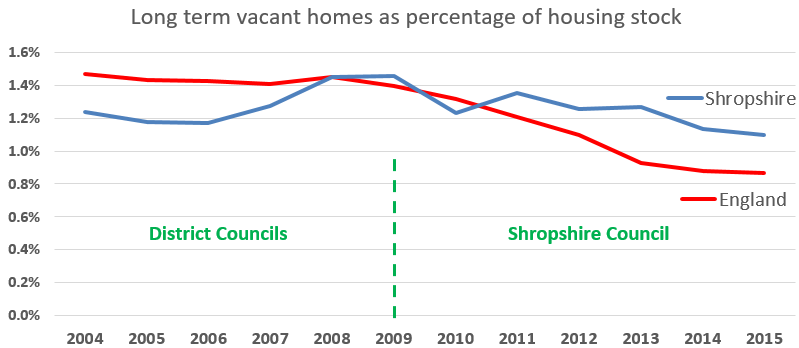Questions will be asked at a Shropshire Council meeting this Thursday to try to find to why this county has such a poor record on bringing empty homes back into use.
If Shropshire Council had kept up with the national trend on reducing empty homes, we would have another 770 homes available in the county right now. If it had just kept up with reducing the number of homes that have been empty for more than six months, then we would have an extra 323 homes in occupation.
Why is this? The main problem in this county has been a lack of investment. Shropshire Council is now investing less than ever and denying itself future income.
Shropshire used to beat the national trend on bringing empty homes back into use. But since the unitary authority was created in 2009, it has trailed behind. Nationally, the number of long-term empty homes, those vacant for more than six months, has fallen by 36% since 2009. In Shropshire, the drop has been just 21%.


Long term empty homes have been vacant for 6 months or more
The unitary council used to have empty housing action zones, where it worked hard to bring vacant properties back into use. It used to give empty property incentive grants. But it abandoned these initiatives without fanfare on 10 May.
Shropshire Council has failed to invest in reducing the number of empty homes since the day it was created. Now it seems to have given up altogether.
If the council brings an empty home back into use, it gets a payment from the government equivalent to six years council tax for the property. For an average property in Shropshire, this will bring in an income of around £9,000 over six years.
By not keeping up with the national pace, we have lost out on more than £1 million in government new homes bonus grants – money that could have been used to bring more empty homes back into use. We would also have another 770 homes in occupation across the county. Something is desperately wrong with our policies in Shropshire if we are trailing behind the rest of the country when we were once well ahead of the game.
People desperate for housing will be shocked by these numbers.
We are told day in day out that we need more housing. Of course we do. One of the fastest ways to deliver new housing is to bring empty homes back into use.
At the Enterprise and Growth Scrutiny meeting on Thursday 2 June, Lib Dem group leader Roger Evans will ask a series of questions aimed at finding out why Shropshire Council’s empty homes policy has all but ground to a halt.
Empty homes data
The number of empty homes has fallen, both nationwide and here in Shropshire.[1] But the fall Shropshire has been slower than across England as a whole since 2009.
In October 2015, there were 4,317 empty homes in Shropshire, 3.1% of the county’s housing stock of 139,120 homes. More than one third of these homes (35%) had been empty for more than 6 months (1,526 long-term vacant homes; 1.1% of housing stock).
In England in the same month, 600,179 homes were empty, 2.55% of the total housing stock. More than a third of these homes (34%) had been empty for more than 6 months (203,596 long-term vacant homes; 0.9% of housing stock).
Back in the heady days of 2004, Shropshire had a better record on empty homes than the rest of England. Looking at all empty homes recorded on 1 November 2004, 3.3% of England’s housing stock was empty. In Shropshire, then run by the five district councils, 2.9% of the housing stock was empty.
Notes
[1]. The statistics in this article is based on data published by the Office of National Statistics, 28 April 2016; Tables 100, 125 and 615.


I think there can be little doubt by now that Shropshire Council’s reputation is one of incompetence; thinking of their laughable entrée into the private sector Ip&e could well have stood for incompetence paramount and evident.